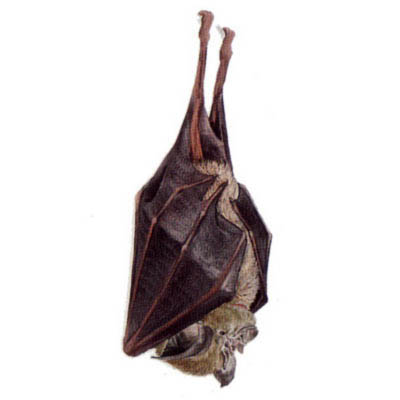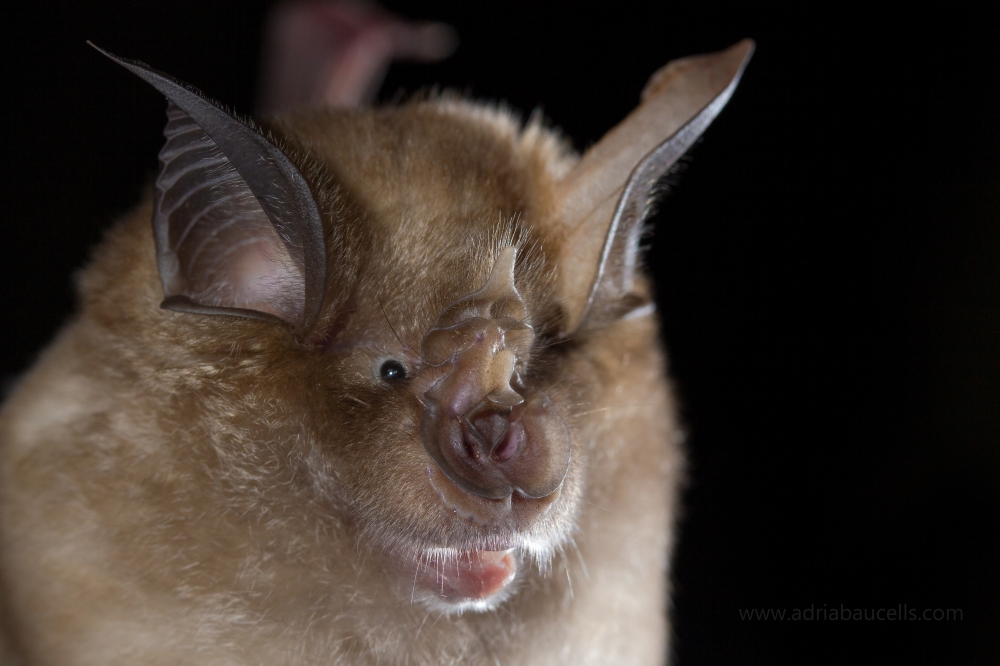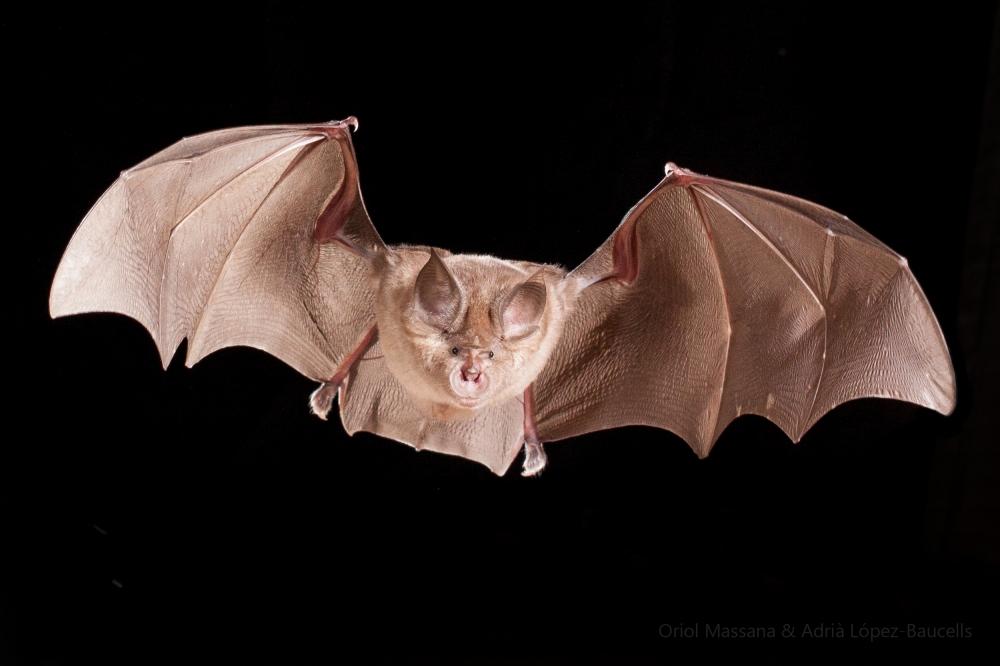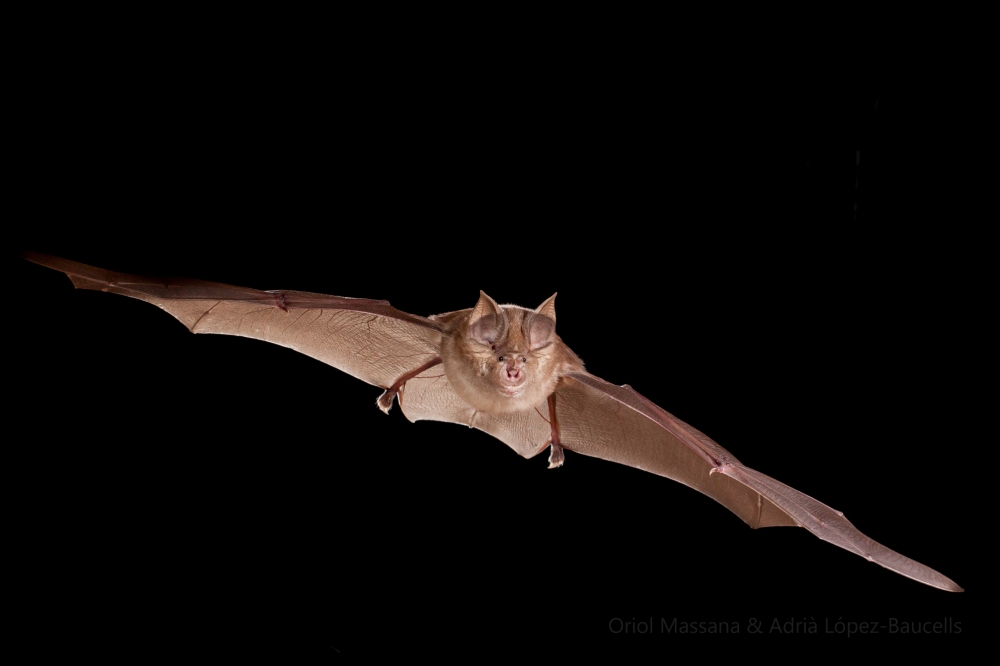Greater horseshoe bat

Rhinolophus ferrumequinum (Scheber, 1774)
Rhinolophidae
Least Concern
| Other names | |
|---|---|
| Catalan | Ferradura grossa |
| Spanish | Murciélago grande de herradura |
| English | Greater horseshoe bat |
| French | Grand rhinolophe |
| Basque | Ferra-saguzar handi |
| Galician | Morcego de ferradura grande |
Description
Fotografies
Distribution
Its distribution ranges from northwest Africa throughout Mediterranean Europe, including the larger islands and central Europe. The northern limit of its distribution is found in Wales, in the United Kingdom. Formerly, it extended to the Netherlands, Germany, Poland, and Ukraine, although in recent decades, its distribution has been greatly reduced due to significant population declines in these regions. To the east, its distribution extends to the Pacific, passing through the Caucasus, Iran, Afghanistan, Pakistan, and the Himalayas. Although more information is needed about its eastern populations, it is believed to also be present in China, Korea, and Japan.
Roosts and phenology
It is a cave-dwelling species, and the roosts are usually lofts in farmhouses or hermitages, although in the southern part of its distribution area, it is more frequently found in caves. Maternity colonies range from tens to hundreds of individuals (although up to 1,000 individuals have been found in breeding shelters in the southern part of its distribution area), typically in buildings or underground shelters. They tend to form dense clusters, although they may be more scattered when temperatures are high. Sometimes, they can be found in mixed colonies with other cave-dwelling species such as the Mediterranean horseshoe bat (Rhinolophus euryale) or the Geoffroy's bat (Myotis emarginatus). Females usually have a single offspring during the months of June and July, and juveniles become independent in August.
In Great Britain, females typically have their first offspring around 6 years of age, and in Bulgaria, around 2 years of age. It is considered a sedentary species, although movements of 20 to 30 km are known, from maternity roosts to hibernation roosts. However, occasional movements of over 100 km have been recorded. During the winter, they can be found in underground shelters such as mines and caves, with temperatures between 4 and 13º C and high relative humidity, with populations ranging from 30 to 500 individuals.
Habitat and diet
It feeds in pastures, forests, and shrublands, adapting to a wide variety of environments such as coniferous forests, pastures, and forest vegetation margins. Mosaic habitats seem to favour its presence, especially in central Europe. Linear vegetation structures are often necessary for the colonization of new areas. Typical hunting areas are usually riparian and coniferous forests. It is generally found below 800 m above sea level, but in some regions like the Mediterranean, it can be found up to 1,500 m in altitude, although it usually prefers thermophilous environments.
Its diet consists mainly of beetles, nocturnal lepidopterans, and to a lesser extent, hymenopterans, dipterans, other insects, and spiders. The flight is slow and usually at low heights (although they can fly up to 6 meters) and they tend to hunt near shrubby and arboreal vegetation or near the ground in meadows. This species uses its wide wings to catch prey in flight. Typically, it feeds within a radius of about 5 km from its roost. Like many rhinolophids, it often hunts by hanging from a branch and catching prey after an agile and short flight, finally consuming it while hanging.
Echolocation
Echolocation is typical of the genus Rhinolophus and is characterized by constant frequencies with a peak frequency of maximum intensity ranging from 79 to 84 kHz. Their staple-shaped calls, typically have a duration ranging from 30 to 40 ms. They are easily identifiable acoustically.
Trends
| General trend | Uncertain |
|---|---|
| Protocol | ChiroRoosts |
| Period | Hibernation |
| Geographic scope | Catalonia |
| Number of localities studied | 22 |
| Annual change | 4.7 % |
| Method | TRIM |
| Analysis execution date | 01/09/2024 |
| General trend | Strong increase |
|---|---|
| Protocol | ChiroRoosts |
| Period | Migration |
| Geographic scope | Catalonia |
| Number of localities studied | 38 |
| Annual change | 9.8 % |
| Method | TRIM |
| Analysis execution date | 01/09/2024 |
| General trend | Moderate increase |
|---|---|
| Protocol | ChiroRoosts |
| Period | Reproduction |
| Geographic scope | Catalonia |
| Number of localities studied | 15 |
| Annual change | 3.8 % |
| Method | TRIM |
| Analysis execution date | 01/09/2024 |
Status
According to the IUCN Red List, it is considered Least Concern, indicating a low level of concern for its conservation status, but with a negative population trend. These bats are protected by national laws, as well as agreements such as the Eurobats Agreement, the Bern Convention, and the European Habitat and Species Directive. The main threats are related to the loss of hunting habitats and flight routes, as well as direct disturbances to their shelters. Pesticides also impact their hunting areas and insect availability.





